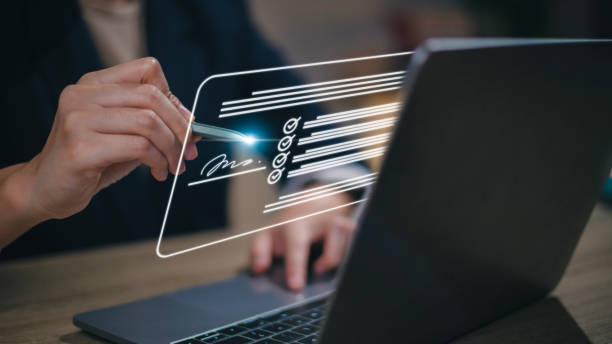Unlocking the Power of Electronic Signatures for Windows Users

Introduction
As our lives become more digital, it’s important to find secure and efficient ways to sign documents. Electronic signatures are a convenient solution for professionals, students, and anyone who wants to simplify paperwork. In this guide, we’ll explore how to sign PDFs on Windows using electronic signatures. It’s an easy and innovative way to sign documents without printing, scanning, or manual signatures. Let’s dive into the simple process of signing PDFs on Windows with electronic signatures.
Step 1: Choose a Reliable Electronic Signature Software
To get started with electronic signatures, you need to choose trustworthy software that meets your requirements. There are various top-notch options available for Windows users, each with its own special features and advantages. Here are some well-known choices:
1. Adobe Sign
2. DocuSign
3. HelloSign
These software solutions have user-friendly interface, strong security measures, and easily integrate with your document management systems.
Step 2: Install and Set Up the Electronic Signature Software
Once you’ve chosen the electronic signature software that you want to use, it’s time to install and set it up on your Windows computer. Here is how to get started:
1. Visit the software provider’s website and download the installation file.
2. Double-click on the downloaded file and follow the on-screen instructions to install the software.
3. Launch the software and create an account by providing the required information.
4. Set up your profile and customise your signature preferences.
Step 3: Open the PDF Document
Now that you have the E-Signature software installed, it’s time to open the PDF that needs your signature. You can either open the document directly within the software or use the softwares integration with familiar file management platforms like Microsoft Office and Adobe Acrobat.
Step 4: Insert Your Electronic Signature
With the PDF document open, follow these steps to insert your electronic signature:
1. Locate the “Insert Signature” option within the software’s toolbar or menu.
2. Choose the type of electronic signature you prefer. You can either draw your signature using your mouse or stylus, type your name and select a font, or upload an image of your handwritten signature.
3. Position the signature within the designated signature field in the PDF document.
Step 5: Verify and Finalise Your Signature
Before you officially add your signature, it is important to check and make sure it is right. Verify that your signature is clear, and does not cover any other texts and images in the document. Now the PDF document has been successfully signed using an electronic signature.
Centilio is an innovative electronic signature solution designed to elevate your document signing experience on Windows devices. With a user-friendly interface and robust security measures, Centilio offers a diverse range of signature options to meet your personal preferences. It seamlessly integrates with existing document management systems and allows for convenient signature placement within PDFs. Centilio ensures legal validity, data security, and accessibility, making it a transformative tool for efficient and reliable electronic signatures.

Your Questions Answered!
Q1: Are electronic signatures legally binding?
A1: Yes, electronic signatures are legally binding in many countries, including the United States, Canada, the European Union, and more. These signatures carry the same legal weight as traditional ink signatures, thanks
to legislation such as the Electronic Signatures in Global and National Commerce Act (ESIGN) in the U.S. and the eIDAS Regulation in the EU.
Q2: Can I use electronic signatures for sensitive documents?
A2: Absolutely! Electronic signatures offer robust security measures to protect your sensitive information. The leading electronic signature software providers utilise advanced encryption algorithms, multi-factor authentication, and audit trails to ensure the integrity and confidentiality of your documents.
Q3: Do I need to print and scan the document after signing electronically?
A3: No, that’s the beauty of electronic signatures! Once you have signed the document electronically, there’s no need to print or scan it. The electronic signature becomes an integral part of the PDF file, making it legally valid and easily shareable.
Q4: Can I sign PDFs on Windows using a touchscreen device?
A4: Yes, if you have a touchscreen-enabled Windows device, you can utilise the touch capabilities to sign PDFs directly on the screen. Many electronic signature software solutions offer touch-friendly interfaces, making the signing process seamless and intuitive.
Q5: Are there any limitations to using electronic signatures?
A5: While electronic signatures offer numerous advantages, it’s essential to consider any limitations or specific requirements based on your jurisdiction or industry. Some documents, such as wills or certain court-related forms, may require traditional ink signatures. Always consult local regulations or seek legal advice when dealing with specialised documents.
Q6: Can I sign PDFs on Windows using a digital certificate?
A6: Yes, if you possess a digital certificate issued by a trusted certification authority, you can utilise it to sign PDFs on Windows. Digital certificates provide an extra layer of authentication and security, ensuring the integrity of your electronic signature.
Embrace the Efficiency of Electronic Signatures on Windows
Signing PDFs on Windows with E-Signatures has completely transformed how we deal with documents. By following these steps, you can save time, resources, and embrace newer technology. E-Signatures provide convenience, security and legal validity in the digital world.
